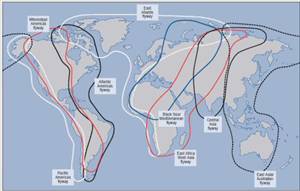Will wild animals spread radiation away from the dead zone around Japan’s nuclear power plant? Humans haven’t even been allowed back in within 20 km to pick up their cars or keepsakes. But wildlife doesn’t recognize the border.
Air: The East Asia-Australia Flyway is one of nine major bird migration routes that birds hop on in the world. Birds fly a migration superhighway from Siberia to Australasia. BirdLife says 50 are globally threatened.
Land: Many farm animals in the area like pigs died because they were confined in stalls, a recent BBC story on a holdout farmer showed, but some escaped and have had feral piglets. Yomiuri Shinbun says that wild boars have been tested and found with 563-3221 becquerel of radioactive cesium per kilogram of meat from wild boar’s head–some well above the standard of 500 that’s considered safe for humans to eat.
Sea: Whales, dolphins, tuna and other fish migrate in and out of Japanese waters. In the spring Nature predicted sea creatures that live permanently off the coast were the worst off.
Now that time has passed, the disaster turns out to be about twice as bad as Japan thought in the spring, The Scientist reports. But it will be a long time before we figure out how badly wildlife will be impacted and how far they may spread the radiation. The area around Chernobyl has become an odd wildlife sanctuary, one of the few places wolves thrive unperturbed. It may be this tragedy ends up leading to a similar land and sea wildlife haven.
Where to See Wildlife in Asia



Sealions are dying EVERYWHERE from Socal to Alsaka…this artical is bullshit
[…] Wildlife near Fukushima: thriving but radioactive […]